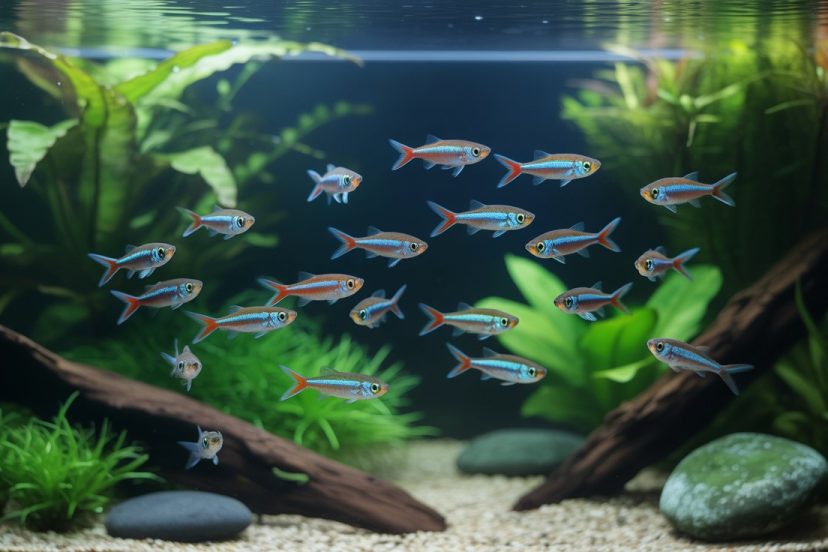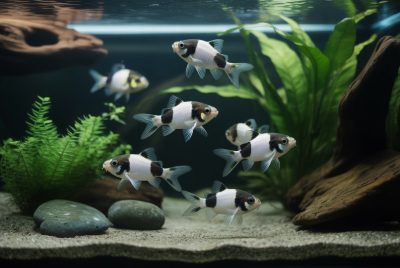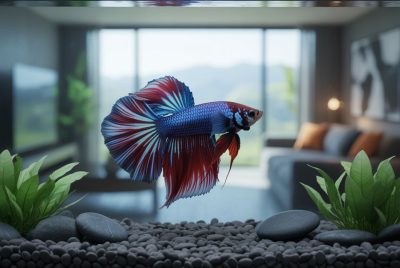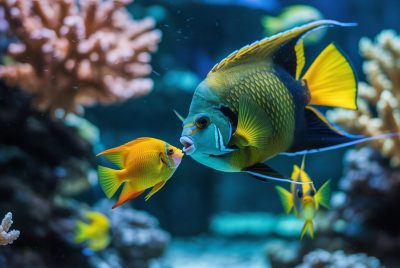Neon Tetra Care 101: Everything You Need to Know
*We may earn a commission for purchases made using our links. Please see our disclosure to learn more.
The journey into the world of aquarium keeping often begins with a single decision: choosing the right fish. For many enthusiasts, that moment arrives when they first witness neon tetras darting through a beautifully planted tank, their iridescent bodies glowing under gentle lighting. These small but stunning fish have captivated aquarists for decades, and for good reason. However, beneath their elegant appearance lies a set of specific care requirements that, when understood and properly implemented, can transform a casual hobby into a deeply rewarding lifestyle pursuit.
Creating the perfect environment for neon tetras isn’t just about maintaining a tank—it’s about building a thriving ecosystem that promotes wellbeing and natural behavior. The process demands attention, patience, and a willingness to learn from both successes and setbacks. For anyone considering these remarkable fish, understanding their needs represents the first step toward creating a truly vibrant aquatic community.
“The neon tetra’s brilliant coloration is one of nature’s most stunning achievements, but beauty demands responsibility.”
— Aquarium Science International
Key Takeaways
- Tank Requirements: Neon tetras need a minimum of 10-gallon tank with stable water parameters to thrive
- Water Conditions: They prefer slightly acidic water (pH 4.0-6.0) with temperatures between 72-76°F and regular maintenance schedules
- Social Behavior: These fish are schooling species that exhibit less stress and more natural behaviors when kept in groups of at least 6-8 individuals
- Dietary Needs: A varied diet including high-quality flakes, micro pellets, and occasional live foods ensures optimal health and coloration
- Common Mistakes: Overcrowding, poor water quality, and inconsistent feeding patterns are among the most frequent challenges new keepers face
Recommended Neon Tetra Care Products
Aqueon 10-Gallon Starter Kit
The Aqueon Aquarium Fish Tank Starter Kit is the perfect choice for anyone starting their Neon Tetra care journey. This 10-gallon glass aquarium provides the ideal environment for small tropical fish like Neon Tetras. It comes with everything you need — a QuietFlow power filter, preset heater (set to 78°F), LED lighting hood, thermometer, and essential water treatment samples. The LED lights highlight your Neon Tetras’ brilliant blue and red hues, creating a vibrant, relaxing aquatic display. With its easy setup and reliable components, this kit ensures a clean, safe, and stable home for your fish.
If you’re beginning your Neon Tetra care routine, the Aqueon 10-Gallon Aquarium Starter Kit is a reliable and easy-to-use setup that helps maintain ideal conditions for your fish. The included preset heater keeps water consistently warm, while the QuietFlow filter ensures clean, oxygen-rich water — crucial for the health of Neon Tetras. The LED lighting not only enhances your aquarium’s appearance but also highlights the Tetras’ stunning neon colors. Whether you’re a beginner or a casual hobbyist, this starter kit offers a balanced environment for Neon Tetras to thrive in a beautiful, low-maintenance display.
- Complete Setup: Includes all essential equipment for beginners starting Neon Tetra care.
- Perfect Temperature: Preset heater maintains 78°F — ideal for tropical fish like Neon Tetras.
- Brilliant Display: LED lighting enhances the vivid colors of Neon Tetras beautifully.
- Limited Space: 10 gallons may be too small for large community setups.
- Plastic Hood: Some users prefer glass tops for longer durability.
- Filter Noise: Filter can be slightly louder compared to premium models.
Fluval Aqua Plus Water Conditioner
The Fluval AquaPlus Water Conditioner is an essential part of Neon Tetra care, ensuring safe and stress-free aquarium water. This all-natural formula instantly neutralizes harmful chlorine, chloramine, and heavy metals commonly found in tap water. Enriched with herbal extracts, it helps reduce fish stress during water changes or transportation, while its protective coating shields delicate Neon Tetra scales and fins from abrasions. Suitable for both freshwater and saltwater aquariums, this conditioner promotes a healthier, more stable environment for your tropical fish.
When it comes to maintaining perfect Neon Tetra care, Fluval AquaPlus Water Conditioner is a must-have. Neon Tetras are sensitive to water quality, and this conditioner instantly removes harmful chlorine and heavy metals from tap water — keeping their environment stable and safe. Its herbal stress-relief formula helps Tetras stay calm during tank cleanings or when introducing new fish. The added slime coat protection strengthens their delicate fins and scales, preventing irritation and damage. For any fishkeeper who wants to keep their Neon Tetras bright, active, and stress-free, Fluval AquaPlus delivers peace of mind in every drop.
- Safe Water: Neutralizes chlorine and toxins instantly for healthy Neon Tetra habitats.
- Stress Relief: Herbal extracts calm fish during tank setup or maintenance.
- Protective Formula: Coats scales and fins to prevent minor injuries.
- Frequent Use: Must be reapplied with every water change.
- Mild Scent: Some users find the herbal aroma strong at first.
- Not Concentrated: Larger tanks may require higher dosages.
Hikari Micro Pellets
The Hikari Tropical Semi-Floating Micro Pellets are a top choice for Neon Tetra care, offering complete, balanced nutrition in every bite. Designed for small tropical fish with tiny mouths, these semi-floating granules slowly sink, allowing Neon Tetras to feed comfortably at mid-water levels. Packed with premium proteins, vegetable ingredients, and color-enhancing nutrients, this food promotes vibrant colors, strong immunity, and healthy growth. The micro pellets are easy to digest, reducing waste and keeping aquarium water cleaner for longer.
For anyone serious about Neon Tetra care, Hikari Tropical Micro Pellets provide the ideal daily diet. Their semi-floating design mimics natural feeding behavior, letting Neon Tetras eat comfortably without stressing or competing at the surface. Each pellet delivers balanced nutrition, including proteins and vegetable extracts that enhance energy and coloration. Hikari’s advanced formula also supports digestive health, reducing waste and keeping your aquarium clean. Trusted by aquarists worldwide, these pellets are perfect for maintaining your Neon Tetras’ bright colors, vitality, and long-term well-being.
- Perfect Size: Micro pellets are ideal for small fish like Neon Tetras.
- Color Boost: Rich in natural color enhancers for brighter, more vibrant fish.
- Clean Feeding: Easy-to-digest formula minimizes water clouding.
- Small Quantity: 0.77 oz pack may run out quickly for larger tanks.
- Semi-Floating Only: May not suit strict surface-feeding fish.
- Requires Sealed Storage: Pellets can lose freshness if left open.
Aqua Innovations Adjustable Heater with Thermostat
The AquaMiracle Adjustable 20W Small Aquarium Heater is a compact yet powerful choice for maintaining the perfect temperature for Neon Tetra care. Designed for nano and small aquariums (2–4 gallons), this “thumb-sized” heater delivers consistent warmth between 64°F and 93°F, ideal for tropical fish like Neon Tetras. Featuring an accurate digital thermostat with real-time temperature display, it ensures precise control within ±1°F. Built-in safety functions prevent overheating and dry running, giving fishkeepers peace of mind. Its mini design blends seamlessly into your tank, keeping your setup neat while maintaining stable conditions for your aquatic pets.
Maintaining stable water temperature is essential in Neon Tetra care, and the AquaMiracle Adjustable 20W Aquarium Heater makes it effortless. Its compact, high-efficiency design keeps your aquarium within the ideal tropical range, helping Neon Tetras stay active, stress-free, and healthy. The digital thermostat provides accurate readings for both current and target temperatures, ensuring precision that traditional knob-controlled heaters can’t match. Safety features such as automatic shutoff for overheating or low water levels protect both your fish and your setup. Perfect for nano tanks or small aquariums, this heater is a smart, space-saving solution for anyone looking to create a stable and comfortable environment for Neon Tetras.
- Precise Control: Digital thermostat maintains steady temperature ideal for Neon Tetras.
- Compact Size: Super mini design saves space and fits small tanks perfectly.
- Safety Features: Includes overheating and low-water protection for peace of mind.
- Small Capacity: Best suited for tanks up to 4 gallons only.
- Digital Display Brightness: May be slightly bright for night viewing.
- Cord Length: Shorter cord may limit placement options in larger setups.
Understanding Neon Tetra Fundamentals
Neon tetras belong to the family Hyphessobrycon innesi and have earned their place as beloved community fish worldwide. Their appeal extends beyond mere aesthetics; these fish represent a gateway into understanding aquatic ecosystems and the delicate balance required to maintain them.
The transformation that occurs when someone commits to proper neon tetra care extends far beyond the aquarium itself. Keepers often report increased sense of calm and focus, as watching these fish navigate their environment provides meditative qualities. The responsibility of maintaining their habitat also fosters discipline and routine, qualities that ripple into other areas of life. Beyond personal benefits, creating a thriving neon tetra community connects individuals to a broader network of aquarists, all united by a passion for these remarkable creatures.
The Emotional Journey: From Admiration to Mastery
Many aquarists describe their entry into neon tetra keeping as an emotional experience. The initial attraction to the fish’s stunning appearance—that unmistakable neon blue stripe running along their bodies—often masks the complexity of their care requirements. This contrast between aesthetic appeal and practical demands creates a meaningful learning curve that separates casual observers from dedicated keepers.
The early challenges of maintaining proper water conditions, establishing stable tank environments, and preventing common diseases like neon tetra disease can feel overwhelming. Yet these obstacles serve as important teachers. When a keeper successfully navigates these challenges, experiencing their first thriving school of neon tetras displaying natural behaviors and vibrant colors, the sense of accomplishment transcends simple hobby satisfaction. It represents mastery over a living system, a direct correlation between knowledge, effort, and positive outcome.
Tank Setup and Environmental Requirements
Creating an optimal environment for neon tetras begins with understanding their natural habitat. In the wild, these fish inhabit slow-moving streams in South America, where dense vegetation provides shelter and dim lighting filters through the water. Replicating these conditions requires thoughtful planning and attention to detail.
Tank Size and Configuration
A minimum 10-gallon tank provides adequate space for a small school of neon tetras, though larger tanks offer more stability and allow for richer communities. The additional water volume in larger tanks dilutes waste products more effectively, making water parameter maintenance less demanding. Many experienced keepers recommend a 20-gallon long tank as an ideal balance between manageability and optimal conditions.
The physical layout matters significantly. Dense aquatic plants create natural hiding spots that reduce stress, while also oxygenating the water through photosynthesis. Live plants like anubias, java ferns, and amazon sword not only aesthetic appeal but also absorb excess nitrates, creating a more stable ecosystem. The substrate should consist of fine sand or small-grain gravel, allowing plant roots to establish while remaining gentle on the fish’s delicate barbels.
Water Parameters and Maintenance
Neon tetras prefer slightly acidic, soft water—a condition that challenges many keepers in regions with naturally hard tap water. Maintaining a pH between 4.0 and 6.0, coupled with water hardness (dGH) of 4-8, creates ideal conditions for these fish. Temperature stability between 72-76°F promotes healthy metabolism and vibrant coloration.
Achieving these parameters often requires creative problem-solving. Some keepers use reverse osmosis water and blend it with tap water to achieve desired softness. Others employ driftwood and peat moss in filters or substrate, which naturally lowers pH over time. These approaches demand patience and experimentation, reflecting the reality that aquarium keeping is as much an art as a science.
Water changes deserve special attention in neon tetra care. Weekly 20-30% water changes remove accumulated waste while preventing dramatic parameter shifts. This routine provides an opportunity for observation, allowing keepers to monitor fish behavior, plant health, and overall tank conditions. Many find this weekly ritual becomes a meditative practice, a dedicated time to connect with their aquatic community.
Behavioral Insights and Social Requirements
Understanding neon tetra behavior reveals why schooling represents more than just preference—it’s essential to their wellbeing. In nature, these fish exist in groups numbering in the hundreds, finding safety, food sources, and social structure within the school. Isolated or kept in pairs, neon tetras exhibit stress behaviors including hiding, faded coloration, and reduced appetite.
Keeping at least six to eight neon tetras together showcases their remarkable schooling behavior. Observers witness coordinated movements, complex hierarchies, and natural feeding patterns that isolated fish never display. The dynamic interactions within a healthy school provide endless fascination and demonstrate the profound difference between merely keeping fish and truly understanding their nature.
Temperament challenges occasionally arise, particularly during the establishment phase of a tank. When neon tetras first enter a new environment, they may hide for days as they acclimate to their surroundings. This period tests a keeper’s patience and understanding. Rather than viewing this as failure, experienced keepers recognize it as normal behavior and maintain consistent care routines, allowing the fish time to adjust at their own pace.
Nutritional Excellence and Feeding Strategies
Providing proper nutrition directly impacts neon tetra health, longevity, and the vibrant coloration that makes these fish so captivating. In the wild, neon tetras feed on small insects, insect larvae, and zooplankton—a varied diet that shaped their nutritional requirements.
Quality dried food forms the foundation of most neon tetra diets. High-quality flakes and micro pellets provide balanced nutrition when selected from reputable manufacturers. However, incorporating live or frozen foods elevates care to a higher level. Brine shrimp, daphnia, and bloodworms provide essential nutrients and stimulate natural feeding behaviors. Many keepers freeze these foods in small portions, thawing only what they need, making supplementation convenient and economical.
The feeding schedule itself requires thoughtfulness. Overfeeding represents a common mistake that degrades water quality and creates health problems. Instead, feeding small amounts twice daily allows fish to consume what they need while leaving minimal waste. Observing the fish during feeding—noting which individuals eat readily and which hesitate—provides valuable insights into tank dynamics and individual health status.
Some keepers experiment with feeding schedules, occasionally fasting neon tetras for a day each week. This practice mimics natural cycles where food availability fluctuates and allows digestive systems to rest. While not essential, this approach appeals to keepers seeking to provide the most naturalistic care possible.
Addressing Common Challenges
The path to successful neon tetra keeping inevitably includes obstacles. Recognizing these challenges early and addressing them systematically prevents minor issues from developing into serious problems.
Water Quality Issues
Perhaps the most common struggle involves maintaining stable water parameters. New tanks experience nitrogen cycling—a biological process where beneficial bacteria establish themselves and convert toxic ammonia into less harmful nitrate. During this critical period, water parameters fluctuate dramatically. Keepers sometimes add neon tetras too quickly, overwhelming the developing bacterial colonies and causing fish stress or death.
Understanding and implementing proper cycling procedures—whether fishless cycling using ammonia or establishing the nitrogen cycle gradually with hardy fish in a separate container—prevents this heartbreak. Testing water regularly using reliable kits transforms guesswork into informed decision-making. When ammonia or nitrite spikes occur, frequent water changes and patience allow the system to recover.
Neon Tetra Disease
This particularly frustrating condition, caused by a parasitic infection, presents as a loss of coloration, curved spine, and erratic swimming patterns. Unfortunately, this disease has no reliable cure and affects stressed fish kept in poor conditions. Prevention focuses on maintaining pristine water quality, minimizing stressors, and avoiding the introduction of infected fish from unreliable sources.
Tank Overcrowding
The excitement of watching multiple neon tetras often tempts keepers to add more fish than their tanks can sustain. Each fish contributes waste to the system, and the nitrogen cycle can only process so much before water quality deteriorates. Calculating proper stocking density—generally one inch of fish per gallon—and resisting the temptation to exceed these guidelines prevents this issue.
Incompatible Tankmates
While neon tetras are peaceful, they sometimes fall prey to larger or more aggressive fish. Choosing compatible community members—considering size, temperament, and territorial behavior—ensures all inhabitants coexist peacefully. Some keepers learn through experience when a combination doesn’t work, requiring the removal of problematic individuals.
The Broader Impact on Lifestyle and Wellbeing
Engaging in neon tetra care often triggers positive changes extending far beyond the aquarium. The discipline required to maintain consistent feeding schedules, perform regular water changes, and monitor water parameters establishes routines that foster overall life organization. This structure, built through aquarium maintenance, frequently influences other life areas.
The meditative quality of observing a thriving neon tetra school provides stress relief and mental clarity. In our fast-paced world, the simple act of watching fish exhibit natural behaviors offers a respite from constant stimulation and demands. Many keepers report improved focus and reduced anxiety, attributing these benefits to regular aquarium time.
Social connections form naturally within the aquarist community. Whether through online forums, local aquarium clubs, or social media groups, keepers find kinship with others who understand the passion for creating thriving aquatic environments. Sharing experiences, troubleshooting problems collaboratively, and celebrating successes builds meaningful relationships centered on a shared passion.
The financial aspect of neon tetra keeping teaches valuable lessons about budgeting and prioritization. While quality equipment requires investment, many keepers become resourceful, researching cost-effective solutions without compromising care standards. This balance between quality and economy applies principles of thoughtful spending throughout life.
Celebrating Progress and Embracing Imperfection
Successful neon tetra keeping acknowledges that perfection remains elusive. Even experienced aquarists face occasional setbacks—a sudden fish death despite proper care, unexpected water parameter fluctuations, or the introduction of unwanted algae. These moments, while disappointing, provide invaluable learning opportunities.
Celebrating small wins maintains motivation and perspective. The first sign of plant growth after initial tank setup, the first successful breeding of neon tetras, or simply observing a full school displaying robust schooling behavior all warrant recognition and appreciation. These milestones, accumulated over time, create a narrative of growth and mastery.
Vulnerability about struggles builds community and authenticity. Sharing experiences with tank failures, fish deaths, or costly mistakes creates space for others to acknowledge their own challenges without shame. This honesty transforms the hobby from isolated pursuit into collective endeavor, where everyone learns from shared experiences.
Creating Connection and Inspiration
The neon tetra’s journey from wild streams to home aquariums mirrors the keeper’s own journey from novice to knowledgeable enthusiast. This parallel transformation—of environment and fish alike—creates meaningful connection transcending typical hobby engagement.
For those considering starting this journey, or for current keepers seeking to deepen their practice, several actionable steps support success. Invest in reliable water testing kits and establish regular testing routines. Research plant species compatible with neon tetra requirements and gradually build a planted environment. Connect with other keepers through aquarium clubs or online communities, learning from their experiences and sharing challenges.
Most importantly, approach neon tetra keeping with patience and curiosity. Accept that learning occurs through both successes and failures, and that each fish teaches something about their nature and your own capacity to care. The transformation that begins with admiration for these glowing fish often extends into personal growth, community connection, and lifestyle enhancement.
Conclusion
Neon tetra care represents far more than maintaining a tank and feeding fish. It embodies a commitment to understanding living systems, practicing discipline, and creating beauty in one’s immediate environment. The journey from initial attraction to these luminous fish to achieving mastery over their care encompasses emotional growth, practical knowledge, and meaningful connection to a broader community of enthusiasts.
The vibrant blue stripes of a thriving neon tetra school serve as visible evidence of dedication, care, and the profound satisfaction that emerges when human effort aligns with natural systems. Whether someone begins their journey today or deepens an existing practice, the path forward offers endless opportunities for discovery, growth, and the quiet joy of witnessing life flourish under thoughtful stewardship.
Frequently Asked Questions
Q1: How many neon tetras can I keep in a 10-gallon tank?
A 10-gallon tank can comfortably house approximately 8-10 neon tetras, following the general guideline of one inch of fish per gallon. However, fewer fish provide more stable water conditions, so starting with 6-8 tetras allows for easier maintenance while still providing adequate schooling behavior.
Q2: What temperature do neon tetras prefer?
Neon tetras thrive in temperatures between 72-76°F. Maintaining stable temperature within this range is crucial for their health, appetite, and coloration. Sudden temperature fluctuations can stress the fish and compromise their immune systems, making them susceptible to disease.
Q3: Can neon tetras live with other fish species?
Yes, neon tetras are peaceful community fish that coexist well with other non-aggressive species. Compatible tankmates include other small tetras, rasboras, corydoras catfish, and peaceful dwarf cichlids. Avoid housing them with large, predatory fish or aggressive species that may harass or consume them.
Q4: How often should I change the water in my neon tetra tank?
Weekly water changes of 20-30% are recommended for optimal water quality. In larger, well-established tanks with robust filtration, some keepers perform changes every 10-14 days. Smaller tanks require more frequent changes due to lower water volume and increased waste concentration.
Q5: Why are my neon tetras losing their color?
Faded coloration often indicates stress caused by poor water conditions, low tank mates compatibility, inadequate diet, or disease. Test water parameters to ensure they remain within proper ranges, verify that all tankmates are compatible, and ensure the fish receive varied, high-quality nutrition. If color loss persists despite proper conditions, neon tetra disease may be present.
















